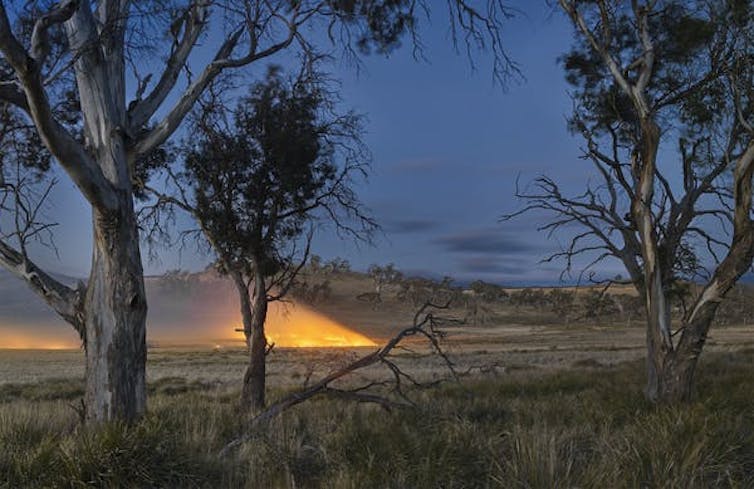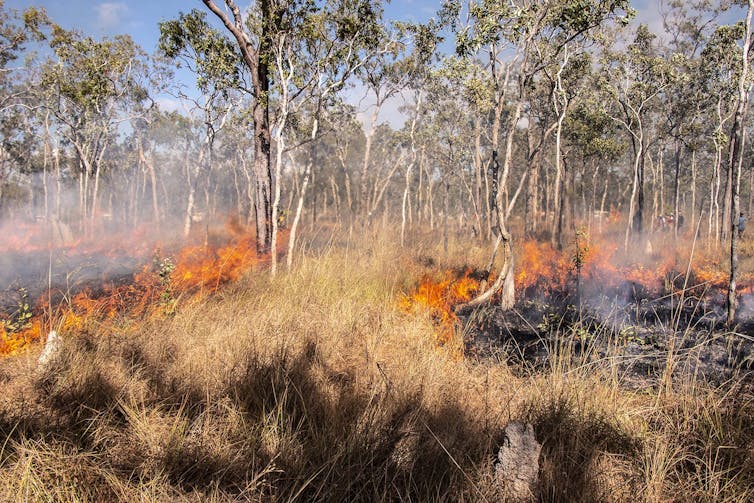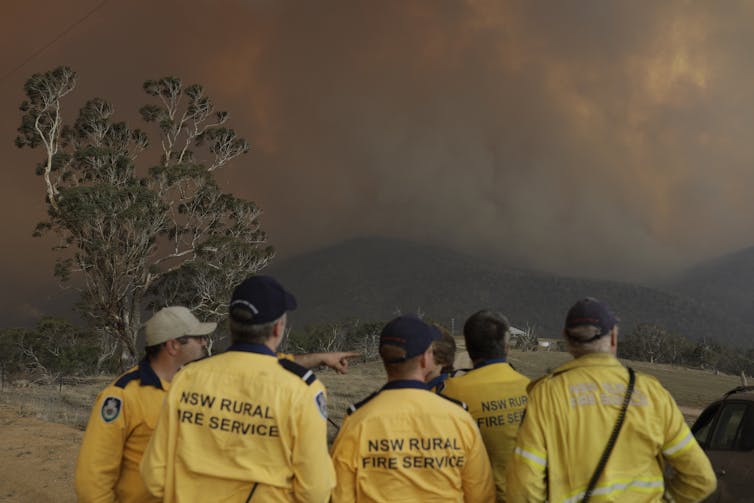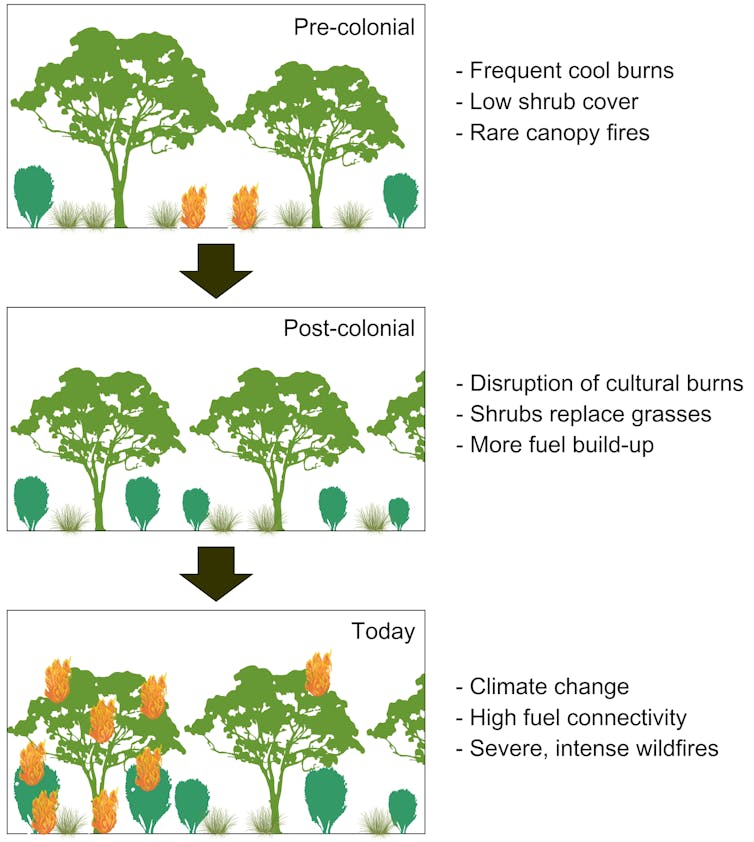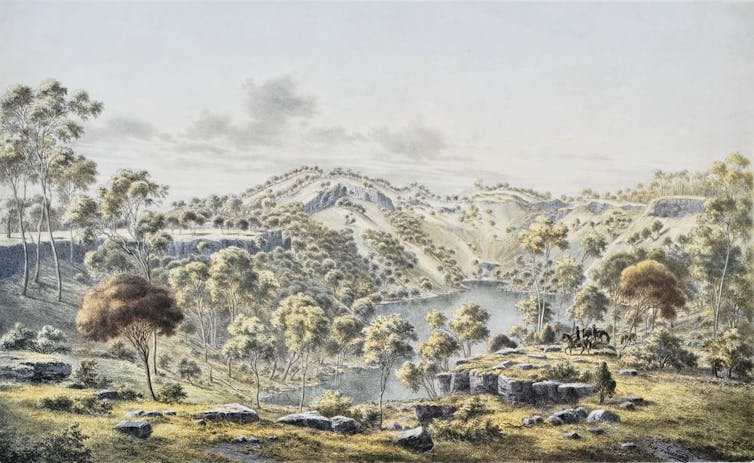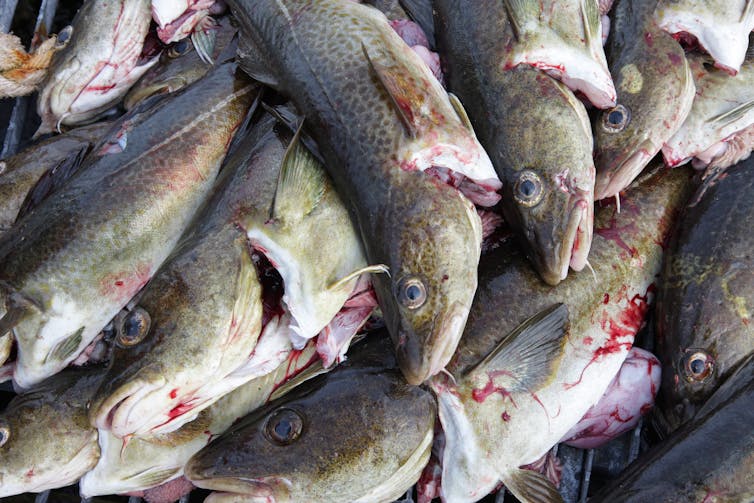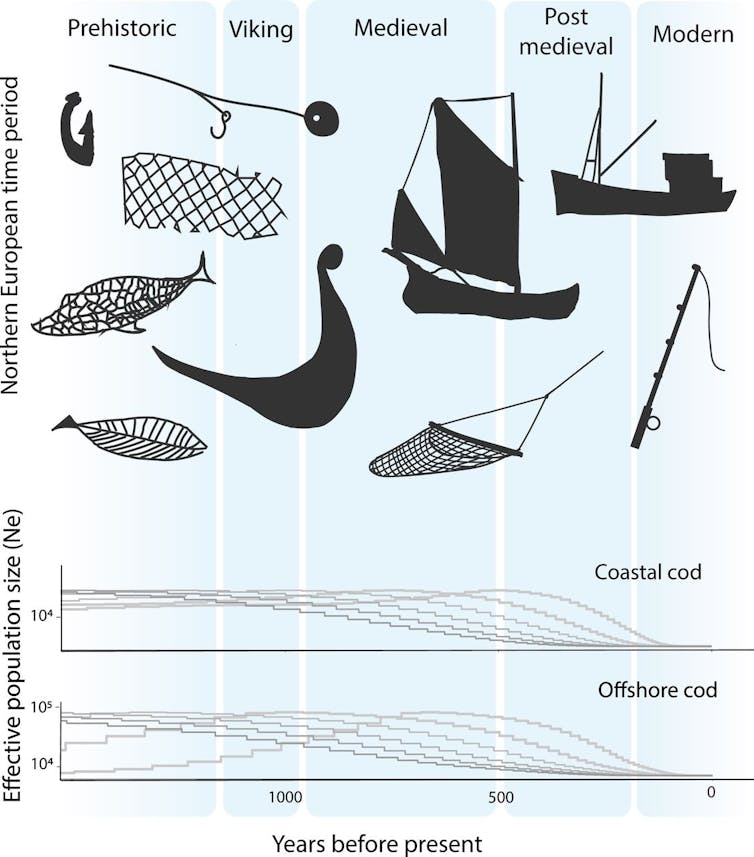How American cash for Canada protests could sway US politics
By RICHARD LARDNER, MICHELLE R. SMITH and ALI SWENSON

A man wearing an American flag walks by police guarding the Canadian parliament building from demonstrators protesting the country's COVID-19 restrictions, Wednesday, Feb. 16, 2022, in Ottawa, Ontario. The protests in Canada that have blocked border crossings with the U.S. and gnarled trade have been promoted, cheered and funded by American anti-vaccine groups, right-wing activists and conservative elected officials. (AP Photo/Robert Bumsted)
WASHINGTON (AP) — The Canadians who have disrupted travel and trade with the U.S. and occupied downtown Ottawa for nearly three weeks have been cheered and funded by American right-wing activists and conservative politicians who also oppose vaccine mandates and the country’s liberal leader.
Yet whatever impact the protests have on Canadian society and the government of Prime Minister Justin Trudeau, experts say the outside support is really aimed at energizing conservative politics in the U.S. Midterm elections are looming, and some Republicans think standing with the protesters up north will galvanize fund-raising and voter turnout at home, these experts say.
“The kind of narratives that the truckers and the trucker convoy are focusing on are going to be really important issues for the (U.S.) elections coming ahead,” said Samantha Bradshaw, a postdoctoral fellow at the Digital Civil Society Lab at Stanford University. “And so using this protest as an opportunity to galvanize their own supporters and other groups, I think it’s very much an opportunity for them.”
Police poured into downtown Ottawa on Thursday, and work crews erected fences around Parliament, in what protesters feared was a prelude to a crackdown.
About 44 percent of the nearly $10 million in contributions to support the protesters originated from U.S. donors, according to an Associated Press analysis of leaked donor files. U.S. Republican elected officials, including Texas Sen. Ted Cruz and Georgia Rep. Marjorie Taylor Greene, have praised the protesters calling them “heroes” and “patriots.”
Fox News host Sean Hannity told two protest organizers on his show on Wednesday that “you do have a lot of support from your friends in America. That I can tell you.” He added: “We have a movement in America that’s starting very soon.”
Trudeau and other senior Canadian officials have been sharply critical of the financial support coming from other countries.
“What this country is facing is a largely foreign-funded, targeted and coordinated attack on critical infrastructure and our democratic institutions,” Bill Blair, Canada’s minister of public safety and emergency preparedness, said earlier this week.
Ian Reifowitz, professor of historical studies at the State University of New York, called the protests a “gift” for Republicans in the U.S., and he predicted they’ll use the populist appeal of the demonstrations to raise money ahead of the midterm elections in November.
“They constantly need fresh outrages,” said Reifowitz, the author of “The Tribalization of Politics: How Rush Limbaugh’s Race-Baiting Rhetoric on the Obama Presidency Paved the Way for Trump.”
“It’s a terrific (issue) eight or nine months before the election for them,” he said. “It allows you to bank money, bank volunteers and energize the base, which is what you want to do.”
Demonstrators in Ottawa have been regularly supplied with fuel and food, and the area around Parliament Hill has at times resembled a spectacular carnival with bouncy castles, gyms, a playground and a concert stage with DJs.
GiveSendGo, a website used to collect donations for the Canadian protests, has collected at least $9.58 million dollars, including $4.2 million, or 44%, that originated in the United States, according to a database of donor information posted online by DDoSecrets, a non-profit group.
The Canadian government has been working to block protesters’ access to these funds, however, and it is not clear how much of the money has ultimately gotten through.
Millions of dollars raised through another crowdfunding site, GoFundMe, were blocked after Canadian officials raised objections with the company, which determined that the effort violated its terms of service around unlawful activity.
The GiveSendGo database analyzed by AP showed more than 109,000 donations through Friday night to campaigns in support of the protests, with a little under 62,000 coming from the U.S.
The GiveSendGo data listed several Americans as giving thousands or tens of thousands of dollars to the protest, with the largest single donation of $90,000 coming from a person who identified himself as Thomas M. Siebel.
Siebel, the billionaire founder of software company Siebel Systems, did not respond to messages sent to an email associated with a foundation he runs and to his LinkedIn account.
A representative from the Siebel Scholars Foundation, who signed her name only as Jennifer, did not respond to questions about whether he had donated the money. But she said Siebel has a record of supporting several causes, including efforts to “protect individual liberty.”
“These are personal initiatives and have nothing to do with the companies with which he is associated,” she wrote.
Siebel has donated hundreds of thousands of dollars to Republican candidates and organizations over the last 20 years, according to Federal Election Commission records, including a $400,000 contribution in 2019 to a GOP fundraising committee called “Take Back the House 2020.”
The GiveSendGo Freedom Convoy campaign was created on Jan. 27 by Tamara Lich. She previously belonged to the far-right Maverick Party, which calls for western Canada to become independent.
The Canadian government moved earlier this week to cut off funding for the protesters by broadening the scope of the country’s anti-money laundering and terrorist financing rules to cover crowdfunding platforms like GiveSendGo.
“We are making these changes because we know that these platforms are being used to support illegal blockades and illegal activity, which is damaging the Canadian economy,” said Canadian Finance Minister Chrystia Freeland.
Perhaps more important than the financial support is the cheerleading the Canadian protesters have received from prominent American conservative politicians and pundits, like Hannity, who see kindred spirits in their northern neighbors opposing vaccine mandates.
On the same day Lich created the GiveSendGo campaign, retired Army Lt. Gen. Michael Flynn shared a video of the convoy in a post on the messaging app Telegram.
“These truckers are fighting back against the nonsense and tyranny, especially coming from the Canadian government,” wrote Flynn, the former head of the Defense Intelligence Agency who served briefly as former President Donald Trump’s national security adviser.
A few days later, Flynn urged people to donate to the Canadian protesters. Earlier this week, he twice posted the message “#TrudeauTheCoward” on Telegram, referring to the prime minister who leads Canada’s Liberal Party.
Fox News hosts regularly laud the protests, and Trump weighed in with a broadside at Trudeau, calling him a “far left lunatic” who has “destroyed Canada with insane COVID mandates.” Cruz called the truckers “heroes” and “patriots,” and Greene said she cannot wait to see a convoy protest in Washington.
Sen. Rand Paul, R-Ky., said he hopes truckers come to America and “clog up cities” in an interview last week with the Daily Signal, a news website of the conservative Heritage Foundation.
Far-right and anti-vaccine activists, inspired by the Canadian actions, are now planning American versions of the protests against COVID-19 mandates and restrictions modeled on the Canadian demonstrations.
The protests in Canada have also created a moneymaking opportunity for some, including a chain of “New England for Trump” stores, which were selling merchandise inspired by the demonstrators. A mesh-back “Freedom Convoy 2022” trucker hat goes for $25. —-
Swenson reported from New York, and Smith reported from Providence, Rhode Island. Associated Press writers Amanda Seitz in Washington, Larry Fenn in New York, Frank Bajak in Boston and Camille Fassett in Oakland, California, contributed to this report.

A man wearing an American flag walks by police guarding the Canadian parliament building from demonstrators protesting the country's COVID-19 restrictions, Wednesday, Feb. 16, 2022, in Ottawa, Ontario. The protests in Canada that have blocked border crossings with the U.S. and gnarled trade have been promoted, cheered and funded by American anti-vaccine groups, right-wing activists and conservative elected officials. (AP Photo/Robert Bumsted)
WASHINGTON (AP) — The Canadians who have disrupted travel and trade with the U.S. and occupied downtown Ottawa for nearly three weeks have been cheered and funded by American right-wing activists and conservative politicians who also oppose vaccine mandates and the country’s liberal leader.
Yet whatever impact the protests have on Canadian society and the government of Prime Minister Justin Trudeau, experts say the outside support is really aimed at energizing conservative politics in the U.S. Midterm elections are looming, and some Republicans think standing with the protesters up north will galvanize fund-raising and voter turnout at home, these experts say.
“The kind of narratives that the truckers and the trucker convoy are focusing on are going to be really important issues for the (U.S.) elections coming ahead,” said Samantha Bradshaw, a postdoctoral fellow at the Digital Civil Society Lab at Stanford University. “And so using this protest as an opportunity to galvanize their own supporters and other groups, I think it’s very much an opportunity for them.”
Police poured into downtown Ottawa on Thursday, and work crews erected fences around Parliament, in what protesters feared was a prelude to a crackdown.
About 44 percent of the nearly $10 million in contributions to support the protesters originated from U.S. donors, according to an Associated Press analysis of leaked donor files. U.S. Republican elected officials, including Texas Sen. Ted Cruz and Georgia Rep. Marjorie Taylor Greene, have praised the protesters calling them “heroes” and “patriots.”
Fox News host Sean Hannity told two protest organizers on his show on Wednesday that “you do have a lot of support from your friends in America. That I can tell you.” He added: “We have a movement in America that’s starting very soon.”
Trudeau and other senior Canadian officials have been sharply critical of the financial support coming from other countries.
“What this country is facing is a largely foreign-funded, targeted and coordinated attack on critical infrastructure and our democratic institutions,” Bill Blair, Canada’s minister of public safety and emergency preparedness, said earlier this week.
Ian Reifowitz, professor of historical studies at the State University of New York, called the protests a “gift” for Republicans in the U.S., and he predicted they’ll use the populist appeal of the demonstrations to raise money ahead of the midterm elections in November.
“They constantly need fresh outrages,” said Reifowitz, the author of “The Tribalization of Politics: How Rush Limbaugh’s Race-Baiting Rhetoric on the Obama Presidency Paved the Way for Trump.”
“It’s a terrific (issue) eight or nine months before the election for them,” he said. “It allows you to bank money, bank volunteers and energize the base, which is what you want to do.”
Demonstrators in Ottawa have been regularly supplied with fuel and food, and the area around Parliament Hill has at times resembled a spectacular carnival with bouncy castles, gyms, a playground and a concert stage with DJs.
GiveSendGo, a website used to collect donations for the Canadian protests, has collected at least $9.58 million dollars, including $4.2 million, or 44%, that originated in the United States, according to a database of donor information posted online by DDoSecrets, a non-profit group.
The Canadian government has been working to block protesters’ access to these funds, however, and it is not clear how much of the money has ultimately gotten through.
Millions of dollars raised through another crowdfunding site, GoFundMe, were blocked after Canadian officials raised objections with the company, which determined that the effort violated its terms of service around unlawful activity.
The GiveSendGo database analyzed by AP showed more than 109,000 donations through Friday night to campaigns in support of the protests, with a little under 62,000 coming from the U.S.
The GiveSendGo data listed several Americans as giving thousands or tens of thousands of dollars to the protest, with the largest single donation of $90,000 coming from a person who identified himself as Thomas M. Siebel.
Siebel, the billionaire founder of software company Siebel Systems, did not respond to messages sent to an email associated with a foundation he runs and to his LinkedIn account.
A representative from the Siebel Scholars Foundation, who signed her name only as Jennifer, did not respond to questions about whether he had donated the money. But she said Siebel has a record of supporting several causes, including efforts to “protect individual liberty.”
“These are personal initiatives and have nothing to do with the companies with which he is associated,” she wrote.
Siebel has donated hundreds of thousands of dollars to Republican candidates and organizations over the last 20 years, according to Federal Election Commission records, including a $400,000 contribution in 2019 to a GOP fundraising committee called “Take Back the House 2020.”
The GiveSendGo Freedom Convoy campaign was created on Jan. 27 by Tamara Lich. She previously belonged to the far-right Maverick Party, which calls for western Canada to become independent.
The Canadian government moved earlier this week to cut off funding for the protesters by broadening the scope of the country’s anti-money laundering and terrorist financing rules to cover crowdfunding platforms like GiveSendGo.
“We are making these changes because we know that these platforms are being used to support illegal blockades and illegal activity, which is damaging the Canadian economy,” said Canadian Finance Minister Chrystia Freeland.
Perhaps more important than the financial support is the cheerleading the Canadian protesters have received from prominent American conservative politicians and pundits, like Hannity, who see kindred spirits in their northern neighbors opposing vaccine mandates.
On the same day Lich created the GiveSendGo campaign, retired Army Lt. Gen. Michael Flynn shared a video of the convoy in a post on the messaging app Telegram.
“These truckers are fighting back against the nonsense and tyranny, especially coming from the Canadian government,” wrote Flynn, the former head of the Defense Intelligence Agency who served briefly as former President Donald Trump’s national security adviser.
A few days later, Flynn urged people to donate to the Canadian protesters. Earlier this week, he twice posted the message “#TrudeauTheCoward” on Telegram, referring to the prime minister who leads Canada’s Liberal Party.
Fox News hosts regularly laud the protests, and Trump weighed in with a broadside at Trudeau, calling him a “far left lunatic” who has “destroyed Canada with insane COVID mandates.” Cruz called the truckers “heroes” and “patriots,” and Greene said she cannot wait to see a convoy protest in Washington.
Sen. Rand Paul, R-Ky., said he hopes truckers come to America and “clog up cities” in an interview last week with the Daily Signal, a news website of the conservative Heritage Foundation.
Far-right and anti-vaccine activists, inspired by the Canadian actions, are now planning American versions of the protests against COVID-19 mandates and restrictions modeled on the Canadian demonstrations.
The protests in Canada have also created a moneymaking opportunity for some, including a chain of “New England for Trump” stores, which were selling merchandise inspired by the demonstrators. A mesh-back “Freedom Convoy 2022” trucker hat goes for $25. —-
Swenson reported from New York, and Smith reported from Providence, Rhode Island. Associated Press writers Amanda Seitz in Washington, Larry Fenn in New York, Frank Bajak in Boston and Camille Fassett in Oakland, California, contributed to this report.
Fox News panel erupts after Geraldo calls out right-wing media for 'inciting' Canadian trucker convoys
Brad Reed
February 16, 2022

Fox News' Geraldo Rivera caused a stir on Wednesday when he called out right-wing media for the "incitement" of anti-vax trucker convoys in Canada, which he argued had made lives miserable for ordinary Canadians.
During a debate about the convoys, Rivera's cohosts claimed that the truckers were broadly supported by the Canadian public despite multiple polls showing them to be wildly unpopular.
"You know what is not popular in Canada is this 'Freedom Convoy,'" Rivera argued. "What about the freedom of the homeowners to live in peace? What about the freedom of the shopkeepers to do business? What about the freedom of the autoworkers to get parts?"
In fact, the polls show Rivera is right.
A recent Angus Reid Institute poll showed "more than two-thirds strongly oppose the protesters' approach and behavior"; a Leger poll showed "nearly two-thirds think the protesters are a selfish minority"; a recent Ipsos poll showed 59 percent agreed with the description of the protesters as "anti-vaxxers and bigots"; and a Maru Public Opinion poll showed 56 percent of respondents saying they don't agree with the protests in "any way, shape or form."
Rivera then went on to slam right-wing media for pushing the protests even though they were backfiring in the court of public opinion.
"It is conservative media that has gone from support to incitement," Rivera charged.
"Incitement!" replied an indignant Greg Gutfeld. "Are you saying we're inciting them?!"
Greg Gutfeld claims the Freedom Convoy "is actually being welcomed" by Canadians.\n\nGeraldo: "It is conservative media that has gone from support to incitement."\n\nGutfeld: "Are you saying we're inciting it?!"\n\nGeraldo then points to polls showing large opposition to the protests.pic.twitter.com/no3ytMWZbm— Justin Baragona (@Justin Baragona) 1645049744
REVEALED: Trump-loving Texas CEO who loaned former president his plane sent $20K to 'Freedom Convoy'
John Wright
February 16, 2022

Benjamin Pogue (Facebook)
A Trump-loving Texas construction company CEO — whose father received a pardon from the former president — has been among the top donors to the Canadian "freedom convoy" on the fundraising site GiveSendGo, according to reports.
Benjamin Pogue of McKinney, Texas, the president and CEO of Pogue Construction, donated more than $385,000 to Trump's re-election campaign in 2020, Business Insider reported Wednesday. Pogue's contributions included providing the former president with the use of Pogue's own private jet, the Associated Press reported.
On Sunday, hackers leaked the names of more than 92,000 people who contributed to the anti-vaxx, anti-government freedom convoy through GiveSendGo, a Christian crowdfunding site, which helped raise $8.7 million for the protest.
“My personal contribution reflected my respect for individuals who were willing to take the time and effort to make their voices heard,” Pogue said in a statement to news media, according to the Dallas Morning News. “It is not an endorsement of any illegal activity. Hopefully, the issue is on its way to a peaceful resolution.”
According to the Morning News, following Pogue's contributions to Trump's campaign in 2020, the former president granted a pardon to his father, Paul Pogue.
Paul Pogue, who founded Pogue Construction Company in 1978, pleaded guilty in 2010 to underpaying taxes by more than $400,000 and was sentenced to three years in prison.
Business Insider noted that the freedom convoy "has been linked to Trump supporters in multiple instances."
"Several news outlets have posted photos of the protest that include hats and signs referencing Trump and the slogan 'Make Canada Great Again,'" the report notes. "Local news reported that during the first week of the protests a man was seen riding through the protesters on horseback, carrying a 'Trump 2024' flag."
Trump himself expressed support for the freedom convoy in a statement, saying the protesters were "doing more to defend American freedom than our own leaders by far."
The leaked data from GiveSendGo showed that more than half of donations came from the U.S.
"Also included in the leaked data were the messages that some donors posted alongside their donations," Vice News reported. "The messages contained over 13,000 references to 'God' or 'Jesus' as well as thousands of references to 'tyranny.' While most of the users’ messages were relatively benign, there are a number of more troubling posts, like this from one user: 'I look forward to the day you tyrants are swinging from a noose.'"
John Wright
February 16, 2022

Benjamin Pogue (Facebook)
A Trump-loving Texas construction company CEO — whose father received a pardon from the former president — has been among the top donors to the Canadian "freedom convoy" on the fundraising site GiveSendGo, according to reports.
Benjamin Pogue of McKinney, Texas, the president and CEO of Pogue Construction, donated more than $385,000 to Trump's re-election campaign in 2020, Business Insider reported Wednesday. Pogue's contributions included providing the former president with the use of Pogue's own private jet, the Associated Press reported.
On Sunday, hackers leaked the names of more than 92,000 people who contributed to the anti-vaxx, anti-government freedom convoy through GiveSendGo, a Christian crowdfunding site, which helped raise $8.7 million for the protest.
“My personal contribution reflected my respect for individuals who were willing to take the time and effort to make their voices heard,” Pogue said in a statement to news media, according to the Dallas Morning News. “It is not an endorsement of any illegal activity. Hopefully, the issue is on its way to a peaceful resolution.”
According to the Morning News, following Pogue's contributions to Trump's campaign in 2020, the former president granted a pardon to his father, Paul Pogue.
Paul Pogue, who founded Pogue Construction Company in 1978, pleaded guilty in 2010 to underpaying taxes by more than $400,000 and was sentenced to three years in prison.
Business Insider noted that the freedom convoy "has been linked to Trump supporters in multiple instances."
"Several news outlets have posted photos of the protest that include hats and signs referencing Trump and the slogan 'Make Canada Great Again,'" the report notes. "Local news reported that during the first week of the protests a man was seen riding through the protesters on horseback, carrying a 'Trump 2024' flag."
Trump himself expressed support for the freedom convoy in a statement, saying the protesters were "doing more to defend American freedom than our own leaders by far."
The leaked data from GiveSendGo showed that more than half of donations came from the U.S.
"Also included in the leaked data were the messages that some donors posted alongside their donations," Vice News reported. "The messages contained over 13,000 references to 'God' or 'Jesus' as well as thousands of references to 'tyranny.' While most of the users’ messages were relatively benign, there are a number of more troubling posts, like this from one user: 'I look forward to the day you tyrants are swinging from a noose.'"



